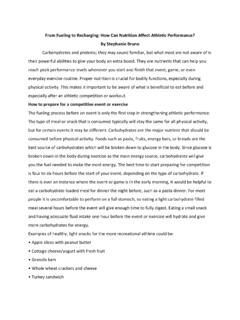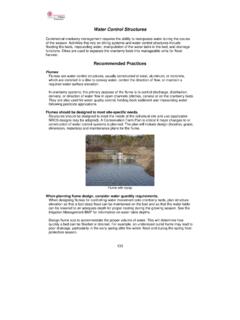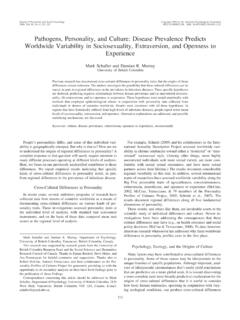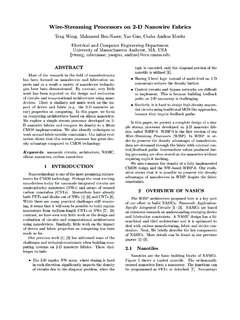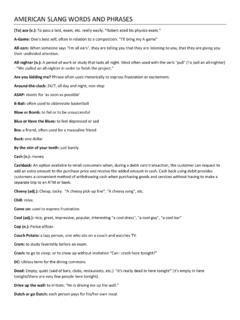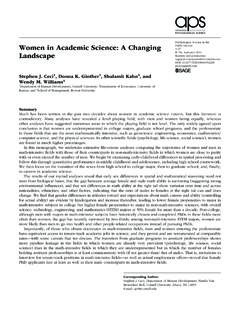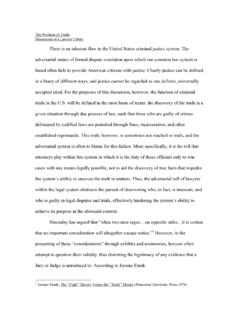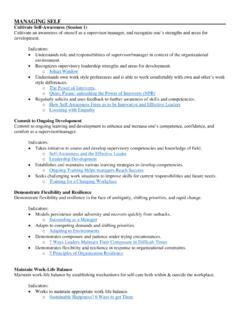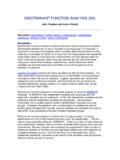Transcription of Discrimination Among Groups - UMass Amherst
1 Discrimination Among Groups P Are Groups significantly different? (How valid are the Groups ?). < Multivariate analysis of Variance [(NP)MANOVA]. < Multi-Response Permutation Procedures [MRPP]. < analysis of group Similarities [ANOSIM]. < Mantel's Test [MANTEL]. P How do Groups differ? (Which variables best distinguish Among the Groups ?). < Discriminant analysis [DA]. < Classification and Regression Trees [CART]. < Logistic Regression [LR]. < Indicator Species analysis [ISA]. 1. Important Characteristics of Discriminant analysis P Essentially a single technique consisting of a couple of closely related procedures. P Operates on data sets for which pre-specified, well- defined Groups already exist. P Assesses dependent relationships between one set of discriminating variables and a single grouping variable; an attempt is made to define the relationship between independent and dependent variables.
2 2. Important Characteristics of Discriminant analysis P Extracts dominant, underlying gradients of variation (canonical functions) Among Groups of sample entities ( , species, sites, observations, etc.) from a set of multivariate observations, such that variation Among Groups is maximized and variation within Groups is minimized along the gradient. P Reduces the dimensionality of a multivariate data set by condensing a large number of original variables into a smaller set of new composite dimensions (canonical functions) with a minimum loss of information. 3. Important Characteristics of Discriminant analysis P Summarizes data redundancy by placing similar entities in proximity in canonical space and producing a parsimonious understanding of the data in terms of a few dominant gradients of variation. P Describes maximum differences Among pre-specified Groups of sampling entities based on a suite of discriminating characteristics ( , canonical analysis of Discrimination ).
3 P Predicts the group membership of future samples, or samples from unknown Groups , based on a suite of classification characteristics ( , classification). 4. Important Characteristics of Discriminant analysis P Extension of Multiple Regression analysis if the research situation defines the group categories as dependent upon the discriminating variables, and a single random sample (N) is drawn in which group membership is "unknown". prior to sampling. P Extension of Multivariate analysis of Variance if the values on the discriminating variables are defined as dependent upon the Groups , and separate independent random samples (N1, N2, ..) of two or more distinct populations ( , Groups ) are drawn in which group membership is "known" prior to sampling. 5. Analogy with Regression and ANOVA. Regression Extension Analogy: P A linear combination of measurements for two or more independent (and usually continuous) variables is used to describe or predict the behavior of a single categorical dependent variable.
4 P Research situation defines the group categories as dependent upon the discriminating variables. P Samples represent a single random sample (N) of a mixture of two or more distinct populations ( , Groups ). P A single sample is drawn in which group membership is "unknown" prior to sampling. 6. Analogy with Regression and ANOVA. ANOVA Extension Analogy: P The independent variable is categorical and defines group membership (typically controlled by experimental design) and populations ( , Groups ) are compared with respect to a vector of measurements for two or more dependent (and usually continuous) variables. P Research situation defines the discriminating variables to be dependent upon the Groups . P Samples represent separate independent random samples (N1, N2, .., NG) of two or more distinct populations ( , Groups ).
5 P group membership is "known" prior to sampling and samples are drawn from each population separately. 7. Discriminant analysis Two Sides of the Same Coin Canonical analysis of Discriminance: P Provides a test (MANOVA) of group differences and simultaneously describes how Groups differ; that is, which variables best account for the group differences. Classification: P Provides a classification of the samples into Groups , which in turn describes how well group membership can be predicted. The classification function can be used to predict group membership of additional samples for which group membership is unknown. 8. Overview of Canonical analysis of Discriminance P CAD seeks to test and describe the relationships Among two or more Groups of entities based on a set of two or more discriminating variables ( , identify boundaries Among Groups of entities).
6 P CAD involves deriving the linear combinations ( , canonical functions) of the two or more discriminating variables that will discriminate "best" Among the a priori defined Groups ( , maximize the F-ratio). P Each sampling entity has a single composite canonical score, on each axis, and the group centroids indicate the most typical location of an entity from a particular group . Hope for significant group separation and a meaningful ecological interpretation of the canonical axes. 9. Overview of Classification Parametric Methods: Valid criteria when each group is multivariate normal. P (Fisher's) Linear discriminant functions: Under the assumption of equal multivariate normal distributions for all Groups , derive linear discriminant functions and classify the sample into the group with the highest score.
7 [lda(); MASS]. P Quadratic discriminant functions: Under the assumption of unequal multivariate normal distributions Among Groups , dervie quadratic discriminant functions and classify each entity into the group with the highest score. [qda(); MASS]. P Canonical Distance: Compute the canonical scores for each entity first, and then classify each entity into the group with the closest group mean canonical score ( , centroid). 10. Overview of Classification Nonparametric Methods: Valid criteria when no assumption about the distribution of each group can be made. P Kernal: Estimate group -specific densities using a kernal of a specified form (several options), and classify each sample into the group with largest local density. [ (); ks]. P K-Nearest Neighbor: Classify each sample into the group with the largest local density based on user- specified number of nearest neighbors.
8 [knn(); class]. Different classification methods will not produce the same results, particularly if parametric assumptions are not met. 11. Geometric View of Discriminant analysis P Canonical axes are X3. derived to maximally separate the three Groups on the first axis. DF2. P The second axis is derived to provide additional separation X1. for the blue and green Groups , which overlap on the first axis. X2 DF1. 12. Discriminant analysis The Analytical Process P Data set P Assumptions P Sample size requirements P Deriving the canonical functions P Assessing the importance of the canonical functions P Interpreting the canonical functions P Validating the canonical functions 13. Discriminant analysis : The Data Set P One categorical grouping variable, and 2 or more continuous, categorical and/or count discriminating variables.
9 P Continuous, categorical, or count variables (preferably all continuous). P Groups of samples must be mutually exclusive. P No missing data allowed. P group sample size need not be the same; however, efficacy descreases with increasing disparity in group sizes. P Minimum of 2 samples per group and at least 2 more samples than the number of variables. 14. Discriminant analysis : The Data Set P Common 2-way ecological data: < Species-by-environment < Species' presense/absence-by-environment < Behavior-by-environment < Sex/life stage-by-enironment/behavior Variables < Soil Groups -by-environment group X1 X2 .. Xp < Breeding demes-by-morphology 1 A x1 1 x1 2 .. x1 p 2 A x2 1 x2 2 .. x2 p < Etc.. n A xn 1 xn 2 .. xn p Samples n+1 B x1 1 x1 2 .. x1 p n+2 B x2 1 x2 2 .. x2 p .. N B xN 1 xN 2 .. xN p 15. Discriminant analysis : The Data Set Hammond's flycatcher: occupied vs unoccupied sites 1 1S0 NO 21 15 75 20 30 0 0 0 0 0 0 0 0 1 1 0 20 40 60 2 1S1 NO 36 15 95 15 35 0 0 0 0 1 0 0 1 0 2 20 20 80 120 3 1S2 NO 30 30 70 10 55 0 0 0 1 2 2 1 0 1 7 140 160 0 300 4 1S3 NO 11 50 70 20 70 0 0 0 0 1 0 0 3 1 5 60 300 0 360 5 1S4 NO 33 40 80 15 65 0 0 1 0 0 0 0 0 0 1 20 160 0 180.
10 49 1U0 YES 3 15 95 20 55 3 0 0 2 1 0 1 1 2 10 80 40 80 200 50 1U1 YES 2 15 80 30 70 5 0 0 1 3 0 0 2 0 11 80 40 180 300 51 1U2 YES 2 65 70 15 70 0 0 0 1 0 0 0 3 0 4 60 60 120 240 52 1U3 YES 30 55 35 25 75 0 0 0 0 3 0 0 3 2 8 20 20 80 120 53 1U4 YES 2 20 95 10 60 2 0 0 0 1 0 0 2 2 7 20 160 40 220 .. 16. DA: Assumptions P Descriptive use of DA requires "no" assumptions! < However, efficacy of DA depends on how well certain assumptions are met. P Inferential use of DA requires assumptions! < Evidence that certain of these assumptions can be violated moderately without large changes in correct classification results. < The larger the sample size, the more robust the analysis is to violations of these assumptions. 17. DA: Assumptions 1. Equality of Variance-Covariance Matrices: DA assumes that Groups have equal dispersions ( , within- group variance-covariance structure is the same for all Groups ).

